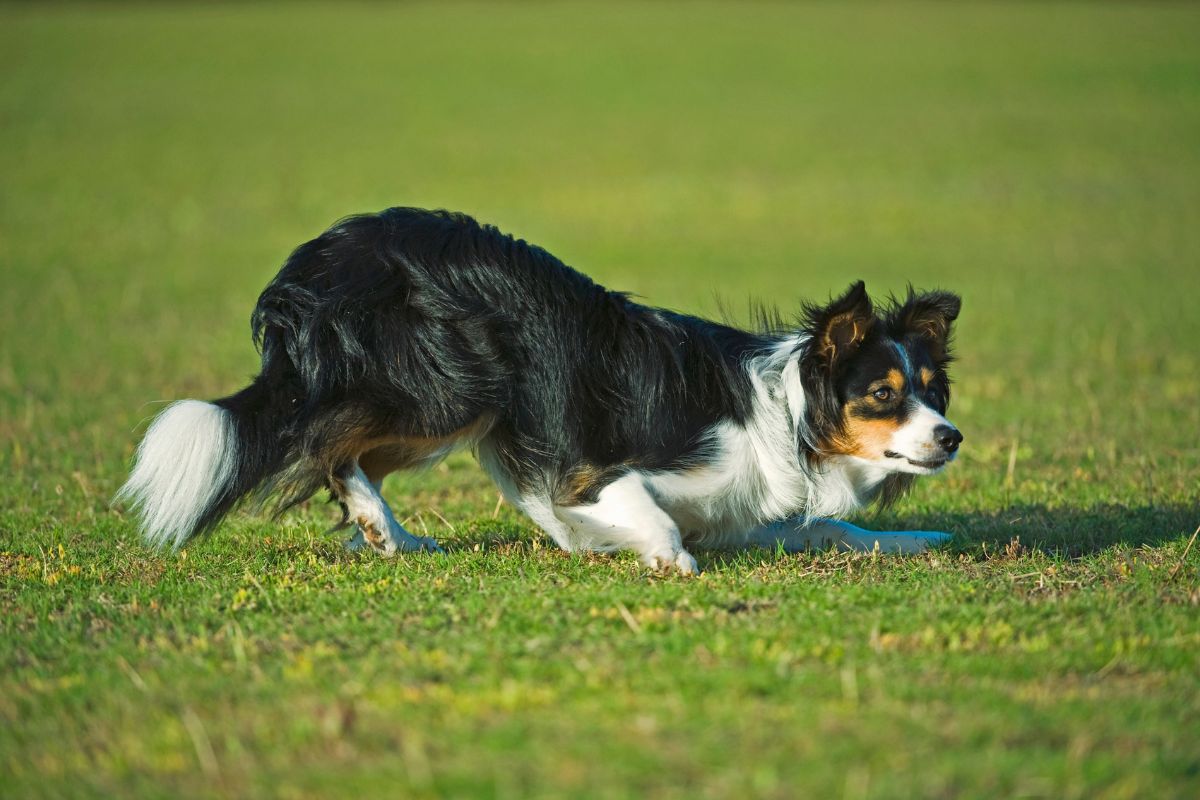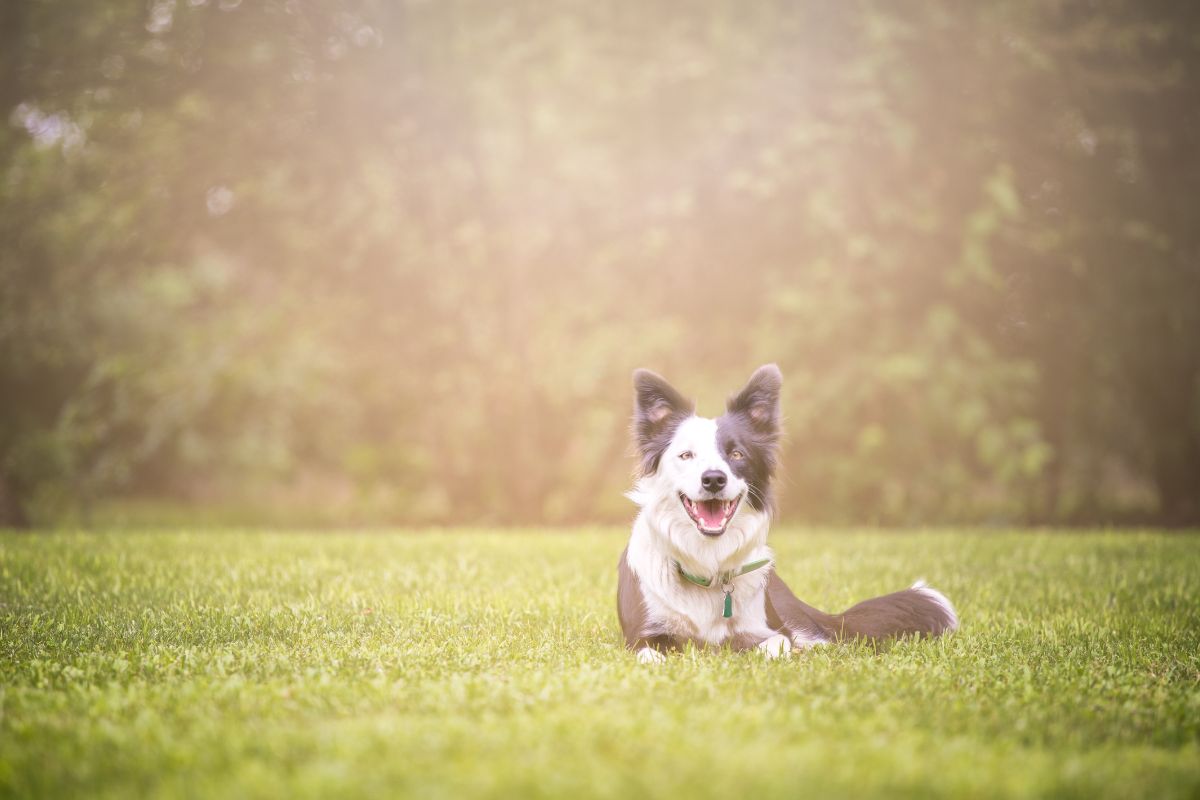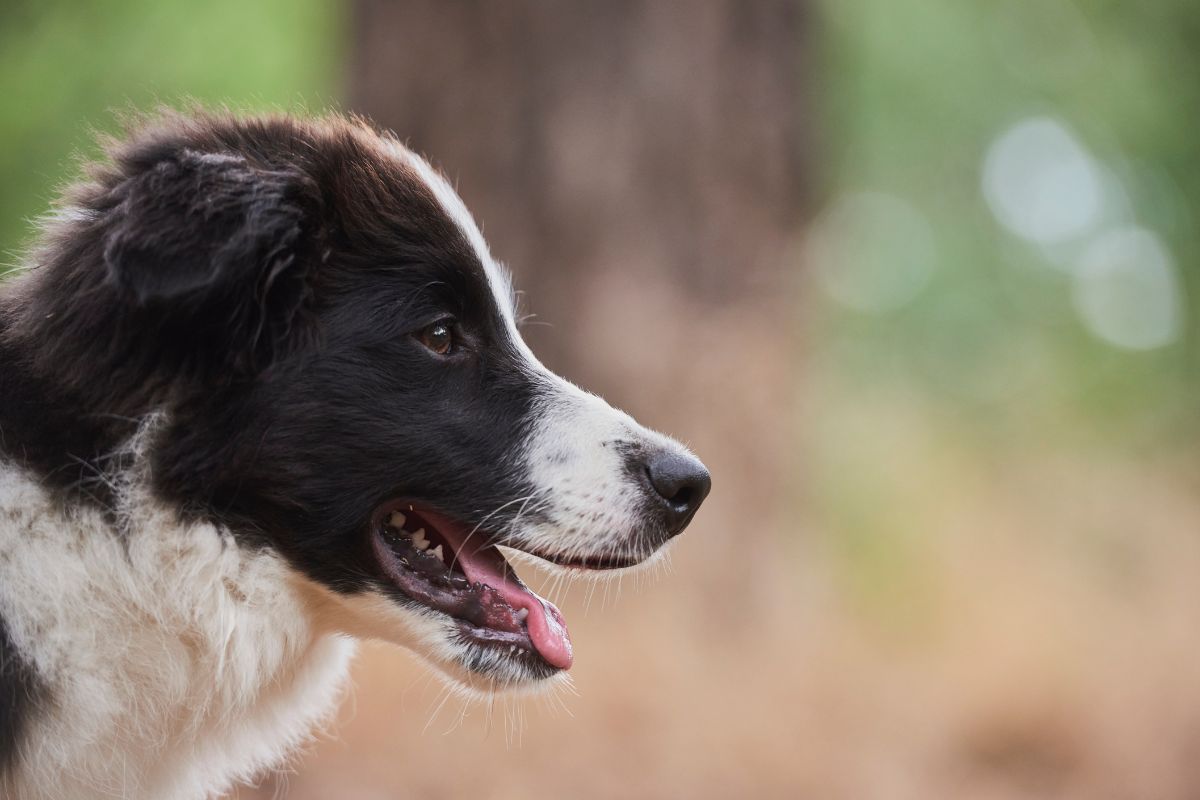Have you met a Border Collie Belgian Malinois Mix pup at the local rescue center and instantly liked each other? Or are you considering getting or breeding one? If so, we recommend checking out our guide on what it means to own a mix between a Border Collie and a Belgian Malinois.
Understanding the pups’ parents’ history, body structure, temperament, trainability, and grooming needs is essential. This way, you can predict what your pup will look like and what traits it will inherit!

What Is a Border Collie Belgian Malinois Mix?
As the breed name suggests, the Border Collie Belgian Malinois Mix refers to a pup born from Border Collie and Belgian Malinois parents.
This breed isn’t too common, but some dogs are born from these two hard-working, energetic, and intelligent dogs!
So what would a Border Collie Belgian Malinois pup look like, what temperament would it have, and how would it feel to have one in and around your household? Let’s find out!
What Do You Call a Malinois Collie Mix?
If you have a Collie and a Malinois and you’re planning to breed them, their pups will be part of a new breed called Malinois Collie Mix. They will inherit both their parents’ traits in terms of appearance, temperament, energy levels, and social adaptability levels.
Malinois Collie dogs will be a mix between their Border Collie parent and their Belgian Malinois parent, thus forming a completely unique breed. For example, Border Collies have a double, wavy, medium-length coat. Belgian Malinois dogs have short, smooth coats. Their pups may have a medium-length, smooth coat, or they can have a short coat with a slightly wavy look.
While it may sound like a good idea to mix these two intelligent and hard-working breeds, it can also have disadvantages, as they can also be aggressive and defensive.
Sometimes people refer to this breed as Malinois Collie Mix, Border Collie Belgian Malinois Mix, Malinois Border Collie Mix, or Belgian Shepherd Collie Mix. Since these dogs are so rare, they don’t have an official designated name yet and don’t belong to a standardized breed.
The Breed’s History
Since the Border Collie Belgian Malinois Mix isn’t a common breed, there isn’t much to tell about its history. However, these pups’ parents have a rich history that’s totally worth discussing. Let’s learn about each!
Border Collie History
Border Collies are a British herding dog breed. These dogs descended from landrace sheepdogs that once lived in the British Isles. Some sources state they originated from the Anglo-Scottish border, and their history can take you back to Old Hemp, considered the progenitor of the Border Collie breed.
Old Hemp was born in Northumberland, England, lived between 1893 and 1901, and belonged to Adam Telfer. It was a tricolor working dog trained to herd sheep. Old Hemp was the puppy of Meg, a black-coated dog, and Roy, a black and tan dog.
If anyone were to research the ancestral lines of every Border Collie in the world, it would lead to Old Hemp. While the dog was alive, it sired as many as 200 pups.
Belgian Malinois History
Belgian Malinois is a Belgian Shepherd breed variation, which is also called Belgian Sheepdog or Chien de Berger Belge. The Belgian Shepherd is a herding dog breed originating from Belgium.
It has four variations classified by coat type and color. These are the long-haired black Belgian Groenendael, the long-haired fawn Belgian Tervuren, the short-haired fawn Belgian Malinois, and the rough-haired fawn Belgian Laekenois.
Belgian Shepherds, Belgian Malinois variation included, descend from a type of shepherd dog that once lived throughout Western Europe. Dutch Shepherd, German Shepherd, and Bouvier des Ardennes are only some breeds believed to have contributed to the appearance of Belgian Shepherd variations.
The breed standardization process started only at the end of the 19th century.
Although these dogs are primarily herding dogs, they’ve been historically significant in serving as assistance dogs, detection dogs, guide and companion dogs, guard dogs, and police and rescue dogs.
Moreover, they served in both World Wars as military dogs. Nowadays, the military still has various tasks for Belgian Shepherds.
People have long believed the Malinois was the first true Belgian Shepherd variety. At a certain point in history, they called the other Belgian Shepherd variations “other-than-Malinois.” Its name comes from the Mechelen region because its coat type was predominant among local shepherds at a time.
The Malinois Collie Mix Temperament
Mixing a Border Collie and a Belgian Malinois may sound like a good idea at first because they’re both extremely intelligent and agile. Some sources state that the Border Collie is the most intelligent dog breed in the world!
However, if we were to analyze the temperaments and needs of both breeds, we’d realize that the two combined won’t result in a perfected breed. Here are some key temperamental features for Border Collie and Belgian Malinois dogs.
| Key Features | Border Collie | Belgian Malinois |
| Family, children, and other dogs | Very affectionate with family, less affectionate with children and other dogs | Moderately affectionate with family, children, and other dogs |
| Openness to strangers | Does well with strangers | Not too open to strangers |
| Playfulness level | Extremely high | Medium |
| Protective nature | Medium | High |
| Adaptability level | Highly adaptable | Medium |
| Trainability level | Highly trainable | Highly trainable |
| Energy level | High | Medium to high |
| Barking level | Medium to high | Medium |
| Mental stimulation needs | High | Medium to high |
Border Collie Temperament
Border Collies’ working temperament makes them playful and energetic on the one hand and extremely demanding on the other hand. The dogs may become destructive and develop problematic behaviors if they don’t get the required mental stimulation and exercise levels. Boredom will make them chew holes in walls and furniture.
Besides this, Border Collies don’t do well alone, ignored, or inactive. Moreover, since they’re historically herding dogs, they may exhibit a strong desire to herd, especially with children or other pets. They can be either shy or anxious and aggressive.
However, since they’re also very eager to please their owners, they’re easy to train. You can diminish the desire to herd by starting training sessions when they’re small and by encouraging early socialization.
Belgian Malinois Temperament
Like Border Collies, Belgian Malinois dogs are brilliant and sensitive. They have a strong guarding instinct. They’re highly trainable and eager to please their owners.
The Malinois variation is the most active among the four Belgian Shepherd variations and doesn’t do well in close environments. Belgian Malinois dogs won’t get enough exercise only by daily walks or half an hour of playing in the backyard.
Moreover, like Border Collies, they may have a strong desire to herd children, other animals, or vehicles and show aggressiveness towards strangers.
Border Collie Belgian Malinois Temperament
We can assume that mixing a Border Collie and a Belgian Malinois will enhance all these traits. People who own Collie Malinois dogs said they were insanely energetic as puppies. Adults would easily become destructive and start breaking things in the house.
On the one hand, they are unbelievably intelligent and might learn a command with only a few repetitions. On the other hand, they also have a very high prey drive. Although this mix may indeed result in some kind of “super dog,” a beginner won’t be able to handle these dogs.
They need to live in a household with experienced dog owners who can work from home or at least have the possibility to spend much time with them. Collie Malinois’s parents should have enough time to give the dogs sufficient exercise and mental stimulation.
If Border Collies and Belgian Malinois dogs are difficult to care about as individuals, just imagine what it means to care for and train a mix between them!
However, other Border Collie Belgian Malinois owners confirmed their dogs are affectionate, playful, and social. So it’s impossible to predict how the pup will turn out because it depends on what traits it will inherit from its parents and what kind of education it’ll get.

What Does It Look Like?
A Border Collie Belgian Malinois will inherit characteristics from both breeds. It may have more in common with its Border Collie parent, more with its Belgian Malinois parent, or it can be an almost equal mix between the two.
Border Collies have thick, medium-length double coats that can be either smooth or rough. Some Collies have slightly wavy coats. Most Border Collies are black and white, but many other color variations are part of the breed standard. These include blue, blue merle, gold, brindle, red, white and red, lilac, and saddleback sable.
Their eyes can be anything from brown to blue, while some dogs, especially merles, may have heterochromia. Border Collies may have fully dropped ears, fully erect ears, or semi-erect ears.
Belgian Malinois dogs are short-haired, and their double coats are fawn with black overlay. Their faces and extremities are charcoal-colored, which makes them look like they’re wearing a mask. Other breed standard colors include mahogany, red, red sable, and fawn sable.
Malinois dogs have long, slender heads, triangular, erect ears, and long, narrow muzzles.
Based on these characteristics, we may assume that a Border Collie Belgian Malinois Mix will have a medium, soft double coat. It may be a combination of black, white, tan, or other shades, depending on its parents’ colors.
They’ll have athletic bodies and erect or semi-erect ears.
The Adult Weight and Height of a Border Collie Belgian Malinois Mix
Border Collie males measure 19 to 22 inches (48.3 to 55.9 cm) tall at the withers, while females measure 18 to 21 inches (45.7 to 53.3 cm) tall. Belgian Malinois dogs are slightly taller. Males grow as tall as 24 to 25 inches (61 to 63.5 cm), while females – 22 to 24 inches (55.9 to 61 cm).
Since their height is approximately the same, we can assume that an adult Belgian Malinois Border Collie Mix will have a similar height at the withers, somewhere between 18 and 25 inches (45.7 to 63.5 cm).
On the other hand, a Border Collie weighs much less than a Belgian Malinois. Its average weight is 30 to 55 pounds (13.6 to 24.9 kg), while the smallest Belgian Malinois weighs 40 pounds (18.1 kg). Male Belgian Malinois dogs weigh roughly 60 to 80 pounds (27.2 to 36.3 kg), while females weigh 40 to 60 pounds (18.1 to 27.2 kg).
So a puppy born from a Border Collie parent and a Belgian Malinois parent may weigh as less as 30 pounds (13.6 kg) and as much as 80 pounds (36.3 kg), depending on whose genes it will inherit.
Pros and Cons of This Breed
A Belgian Malinois and Border Collie Mix has both positive and negative traits – like any other dog breed, after all. If you’re planning to get one, you must consider them because these traits will indicate whether this dog’s needs and temperament will suit your lifestyle.
Let’s see some pros and cons of owning this breed mix:
Pros:
- They’re affectionate
- They’re very easy to train, especially if training sessions start when they’re puppies
- They easily adapt to different environments
- They have a protective nature
- They are eager to play with their families
- They are extremely intelligent and sensitive
- They learn commands fast
- They are hard-working and eager to please their owners, so they’ll do almost everything you’ll ask
Cons:
- They become destructive if bored
- They are very demanding
- They require much exercising over a day
- They do very badly if left alone or isolated
- They may sometimes be too active and have too much energy
- They may develop behavior problems
- They may chew things and dig holes
- They have a strong desire to herd
In short, if you:
- Know you have a lot of free time during the day to go out for runs or to ride your bike
- Rarely go on trips
- Have the energy to play with your pup after your job
- Have previous experience in training a dog
then you’ll definitely have fun with a Malinois Collie Mix!
However, if you’re not sure you can handle their extremely energetic and, at the same time, destructive behavior, you may want to consider another breed.
Are There Any Health Concerns Associated With the Breed?
Like any other breed, a Collie Malinois can suffer from various diseases inherited from their parents or developed over the years.
Belgian Malinois dogs are generally healthy, although some dogs may suffer from skin allergies, eye problems, and hip and elbow dysplasia. A health concern for Belgian Malinois is epilepsy, so if you have a Malinois Mix, you may want to test it.
Border Collies often die from cancer, old age, and cerebrovascular diseases. Other health problems they are prone to include collie eye anomaly, epilepsy, hip and elbow dysplasia, and hearing loss.
A Border Collie Belgian Malinois Mix may suffer from any of these, especially hip and elbow dysplasia, epilepsy, or eye problems, because both parent breeds are prone to these.
It can also develop other diseases not known to its parents. Or, on the contrary, it may die of old age without any severe health issues.
It’s of utmost importance to schedule regular check-ups with the veterinarian to avoid any complications.
The Malinois Collie Mix Lifespan
Belgian Malinois dogs have an average lifespan of 14 years, although some live 10 to 12 years, while others can reach 16 years.
Border Collies live 12 to 15 years on average. Some Collies reached a lifespan of 18 years. Although they are prone to many health issues, their average lifespan is longer than other dogs of similar sizes.
Even though a Malinois Collie Mix pup will inherit its parents’ life expectancies, its lifespan highly depends on the quality of life, how often you take it to the vet, what it eats, and how much exercise and attention it gets.
In a nutshell, if you take great care of your pup and surround it with love and affection, it will live much longer than expected!
Training Advice
If you’re sure you want to get a Malinois Collie Mix, you have to be prepared to start its training sessions from an early age. They will help the pup get used to socialization, diminish its desire to herd, and help avoid difficult behaviors as it ages.
It’s essential to ensure constant training and socialization until they are approximately seven months old.
You may find training easy at times thanks to the dog’s intelligence, eagerness to please, agility, and high energy levels. Other times you’ll find it exhausting. You’ll always need to diversify your activities because this pup will definitely get bored with following the same commands every day.
Including multiple types of training programs into your Malinois Collie’s training schedule may help keep the pup interested. Some training methods are clicker training, obedience training, crate training, and positive reinforcement training. You can start with one method and slowly introduce elements from other training methods.
Moreover, it would help if you bought supplies beforehand. These include treats, dog toys, a leash and harness, and other training tools.
Here are some tips on achieving a good training day:
- Make sure you provide your dog with plenty of exercise outside training sessions. This way, the pup will stay focused when learning commands.
- Consistent, short training sessions are the best because Malinois Collies can easily get bored or distracted. At least one 10 to 20-minute training session per day would be perfect!
- Use short, concise commands and maintain a firm yet kind tone of voice.
- Don’t forget to encourage socialization to help it adapt to people outside the household and to various situations. A few minutes of social exposure a day, while they’re still young, will do their magic!
- Use treats during your training sessions. Your pup will definitely inherit its parents’ eagerness to please, so it would be best to show your furry friend how happy you are if it follows the commands.
- Last but not least, remember that every day means little progress! Be patient today, and in time, you’ll see the results!
One might find it very challenging if one has no experience in training dogs. We suggest seeking professional help, at least in the beginning. There are various training schools people can register their pups in. And eventually, everyone will learn how to train a puppy!
Because Malinois Collies can, at times, be very problematic, we recommend seeking professional advice even if you’ve previously trained dogs.
The Border Collie Malinois Mix’s Grooming Needs
Malinois Collies’ grooming depends on what coat type they have. Will they inherit their Border Collie parent’s medium coat or their Belgian Malinois parent’s short coat? Will they have a rough or a smooth coat?
Border Collies don’t shed too much. Brushing two to three times a week should be enough. They mostly shed during spring and autumn, when they change their coats for the upcoming summer and winter. At this time, they require daily brushing.
Regarding bathing, Collies will be happy with a bath every two to three months. However, this depends on how dirty it gets when it goes out. In addition, Collies should have their nails trimmed at least once a month.
On the other hand, Belgian Malinois dogs don’t require much grooming. Since they have short coats, they won’t develop mats and tangles, so brushing them is easier. Occasional brushing should be enough. During shedding season, the Malinois variation will appreciate daily brushing. A bath every several weeks will help maintain the dog clean.
As a wrap-up, your Malinois Collie will most probably require several brushing sessions a week during non-shedding seasons and daily brushing during shedding seasons. Depending on its lifestyle, a bath every 1 to 2 months should make it happy.
Don’t forget that it’s best to buy grooming tools designed especially for your dog’s coat type. For example, if your pup inherits the Border Collie coat, you may want to get a brush for untangling knots and mats.
Moreover, make sure to check your fluffy friend’s ears, teeth, and nails regularly. If you’re not sure how to do this, you can always ask your veterinarian for a piece of advice!
How Much Does a Puppy Cost?
Mixed breeds usually cost less than pure-bred dogs. On the other hand, Border Collie Belgian Malinois are extremely rare, so they may cost even more than a pure-bred dog. Furthermore, if you want a breeder to get this mixed breed, the price will likely be high.
Family Border Collies usually cost approximately between $500 and $1,800. Buying a Border Collie from the American Kennel Club marketplace may cost you roughly $1,500 to $3,500.
Belgian Malinois puppies are more expensive than Border Collies. On average, they cost around $1,000. However, depending on the breeder and the dog’s bloodline, you can pay up to $3,500 for a Belgian Malinois.
However, if you’ve stumbled upon a Belgian Malinois Border Collie Mix puppy at a dog shelter or rescue center, you’ll likely pay much less.

Final Verdict
If you’re planning to get or breed a Border Collie Belgian Malinois pup, you should consider all the aspects of owning this mixed breed. The dog will definitely be intelligent, affectionate, energetic, and playful! But it can also be destructive, aggressive, and anxious.
Understanding its parents’ lifestyle, temperament, and behavior may help predict what a Collie Malinois will look like and how it will behave!


1 thought on “ADVICE Before Getting a Border Collie Belgian Malinois Mix”
Comments are closed.